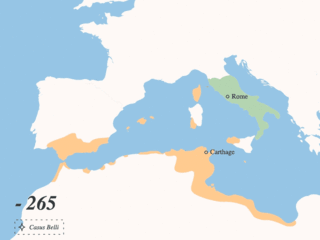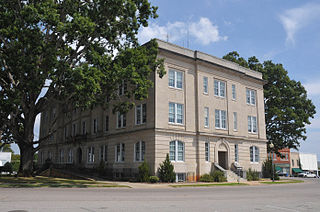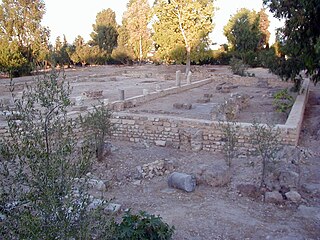
Carthage was the capital city of ancient Carthage, on the eastern side of the Lake of Tunis in what is now Tunisia. Carthage was one of the most important trading hubs of the Ancient Mediterranean and one of the most affluent cities of the classical world.

The Punic Wars were a series of wars between 264 and 146 BC fought between Rome and Carthage. Three conflicts between these states took place on both land and sea across the western Mediterranean region and involved a total of forty-three years of warfare. The Punic Wars are also considered to include the four-year-long revolt against Carthage which started in 241 BC. Each war involved immense materiel and human losses on both sides.

The Second Punic War was the second of three wars fought between Carthage and Rome, the two main powers of the western Mediterranean in the 3rd century BC. For 17 years the two states struggled for supremacy, primarily in Italy and Iberia, but also on the islands of Sicily and Sardinia and, towards the end of the war, in North Africa. After immense materiel and human losses on both sides the Carthaginians were defeated. Macedonia, Syracuse and several Numidian kingdoms were drawn into the fighting, and Iberian and Gallic forces fought on both sides. There were three main military theatres during the war: Italy, where Hannibal defeated the Roman legions repeatedly, with occasional subsidiary campaigns in Sicily, Sardinia and Greece; Iberia, where Hasdrubal, a younger brother of Hannibal, defended the Carthaginian colonial cities with mixed success before moving into Italy; and Africa, where Rome finally won the war.

The Third Punic War was the third and last of the Punic Wars fought between Carthage and Rome. The war was fought entirely within Carthaginian territory, in what is now northern Tunisia. When the Second Punic War ended in 201 BC one of the terms of the peace treaty prohibited Carthage from waging war without Rome's permission. Rome's ally, King Masinissa of Numidia, exploited this to repeatedly raid and seize Carthaginian territory with impunity. In 149 BC Carthage sent an army, under Hasdrubal, against Masinissa, the treaty notwithstanding. The campaign ended in disaster as the Battle of Oroscopa ended with a Carthaginian defeat and the surrender of the Carthaginian army. Anti-Carthaginian factions in Rome used the illicit military action as a pretext to prepare a punitive expedition.

Smith County is a county in the U.S. state of Tennessee. As of the 2020 census, the population was 19,904. Smith County is located in the region of the state known as Middle Tennessee. Its county seat is Carthage. The county was organized in 1799 and is named for Daniel Smith, a Revolutionary War veteran who made the first map of Tennessee and served as a United States senator.

Leake County is a county in the center of the U.S. state of Mississippi. As of the 2020 census, the population was 21,275. Its county seat is Carthage. The county is named for Walter Leake, the Governor of Mississippi from 1822 to 1825.

Hancock County is a county in the U.S. state of Illinois. According to the 2020 census, it has a population of 17,620. Its county seat is Carthage, and its largest city is Hamilton. The county is made up of rural towns with many farmers.

Carthage is a city in and the county seat of Hancock County, Illinois, United States. Its population was 2,490 as of the 2020 census. Carthage is best known for being the site of the 1844 death of Joseph Smith, who founded the Latter Day Saint movement.

Carthage is a city in Jasper County, Missouri, United States. The population was 15,522 as of the 2020 census. It is the county seat of Jasper County and is nicknamed "America's Maple Leaf City."

Carthage is the county seat of Moore County, North Carolina, United States. The population was 2,635 at the 2020 Census. The city is named after Carthage.

Carthage College is a private college affiliated with the Evangelical Lutheran Church in America and located in Kenosha, Wisconsin. It enrolls 2,600 full-time and 200 part-time students.
The Councils of Carthage were church synods held during the 3rd, 4th, and 5th centuries in the city of Carthage in Africa. The most important of these are described below.
Robert Allen was an American merchant and politician from Carthage, Tennessee. He represented Tennessee in the United States House of Representatives from 1819 until 1827.

The Punic people, or Carthaginians, were a Semitic people in the Western Mediterranean who migrated from Tyre, Phoenicia to North Africa during the Early Iron Age. In modern scholarship, the term Punic, the Latin equivalent of the Greek-derived term Phoenician, is exclusively used to refer to Phoenicians in the western Mediterranean, following the line of the Greek East and Latin West.

Edward Coke Crow was a United States Democratic Attorney General from the state of Missouri.

The city of Carthage was founded in the 9th century BC on the coast of Northwest Africa, in what is now Tunisia, as one of a number of Phoenician settlements in the western Mediterranean created to facilitate trade from the city of Tyre on the coast of what is now Lebanon. The name of both the city and the wider republic that grew out of it, Carthage developed into a significant trading empire throughout the Mediterranean. The date from which Carthage can be counted as an independent power cannot exactly be determined, and probably nothing distinguished Carthage from the other Phoenician colonies in Northwest Africa and the Mediterranean during 800–700 BC. By the end of the 7th century BC, Carthage was becoming one of the leading commercial centres of the West Mediterranean region. After a long conflict with the emerging Roman Republic, known as the Punic Wars, Rome finally destroyed Carthage in 146 BC. A Roman Carthage was established on the ruins of the first. Roman Carthage was eventually destroyed—its walls torn down, its water supply cut off, and its harbours made unusable—following its conquest by Arab invaders at the close of the 7th century. It was replaced by Tunis as the major regional centre, which has spread to include the ancient site of Carthage in a modern suburb.

Carthage was a settlement in what is now Tunisia that later became a city-state and then an empire. Founded by the Phoenicians in the ninth century BC, Carthage reached its height in the fourth century BC as one of the largest metropolises in the world and the centre of the Carthaginian Empire, a major power in the ancient world that dominated the western and central Mediterranean Sea. Following the Punic Wars, Carthage was destroyed by the Romans in 146 BC, who later rebuilt the city lavishly.
The 2004 NCAA Division III football season, part of the college football season organized by the NCAA at the Division III level in the United States, began in August 2004, and concluded with the NCAA Division III Football Championship, also known as the Stagg Bowl, in December 2004 at Salem Football Stadium in Salem, Virginia. The Linfield Wildcats won their first Division III championship by defeating the Mary Hardin–Baylor Crusaders, 28−21.

The Archdiocese of Carthage, also known as the Church of Carthage, was a Latin Catholic diocese established in Carthage, Roman Empire, in the 2nd century. Agrippin was the first named bishop, around 230 AD. The temporal importance of the city of Carthage in the Roman Empire had previously been restored by Julius Caesar and Augustus. When Christianity became firmly established around the Roman province of Africa Proconsulare, Carthage became its natural ecclesiastical seat. Carthage subsequently exercised informal primacy as an archdiocese, being the most important center of Christianity in the whole of Roman Africa, corresponding to most of today's Mediterranean coast and inland of Northern Africa. As such, it enjoyed honorary title of patriarch as well as primate of Africa: Pope Leo I confirmed the primacy of the bishop of Carthage in 446: "Indeed, after the Roman Bishop, the leading Bishop and metropolitan for all Africa is the Bishop of Carthage."
Carthage is a commune in Tunis Governorate, Tunisia. It is named for, and includes in its area, the archaeological site of Carthage.


















